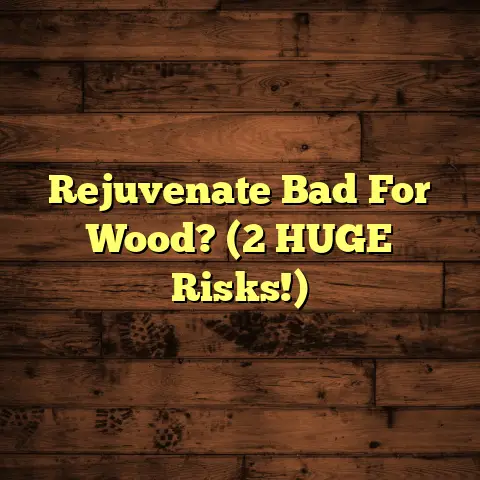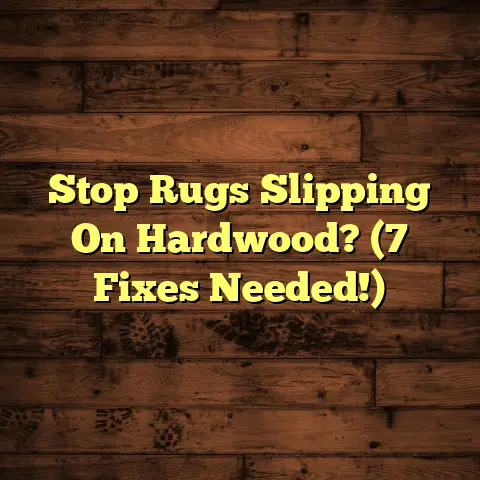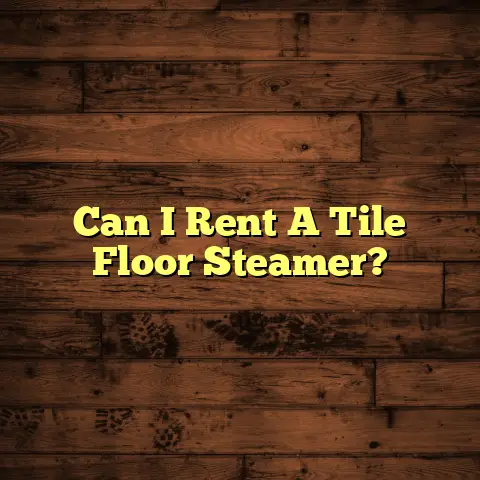Quick Shine on Wood Floors? (9 Things To Consider!)
I get it. A beautifully shined wood floor can transform a space, adding warmth, elegance, and a touch of luxury.
That’s why I’m diving deep into the world of quick shine solutions for your wood floors.
But before you grab the first bottle of polish you see, let’s talk about what it really means to “shine” wood floors.
It’s not just about making them look pretty (though that’s a definite bonus!). It’s about enhancing their natural beauty while protecting them from wear and tear.
Think of it as giving your floors a healthy glow-up!
Shiny wood floors can instantly elevate your home’s aesthetic, making it feel cleaner and more inviting.
Plus, well-maintained floors can actually increase your property value. Who doesn’t want that?
And let’s not forget the protective aspect. A good shine can act as a barrier against scratches, spills, and everyday damage.
In this article, I’m going to walk you through nine essential things you need to consider before attempting a quick shine on your wood floors.
Trust me, taking the time to understand these factors will save you headaches (and potentially costly repairs) down the road.
Ready to get started? Let’s dive in!
Section 1: Understanding Your Wood Floor Type
Okay, before we even think about shining, we need to talk about your floor.
Not all wood floors are created equal, and treating them the same can be a recipe for disaster.
Are you working with solid hardwood, engineered wood, or laminate? Each type reacts differently to cleaning and polishing products.
Solid Hardwood:
This is the real deal – planks made from a single piece of wood.
Think oak, maple, cherry, etc. It’s durable and can be refinished multiple times, but it’s also the most sensitive to moisture.
Engineered Wood:
This is made of layers of plywood with a hardwood veneer on top.
It’s more stable than solid hardwood and less prone to warping, making it a good option for areas with higher humidity.
Laminate:
Laminate isn’t actually wood at all. It’s a synthetic material that mimics the look of wood.
It’s the most budget-friendly option and is very durable, but it can’t be refinished.
Now, let’s talk about the finish on your floor. Is it polyurethane, oil-based, or water-based?
Polyurethane:
This is the most common type of finish. It’s durable, water-resistant, and comes in various sheens (glossy, semi-gloss, satin, matte).
Oil-Based:
This finish penetrates the wood and provides a rich, warm look. It’s durable but can yellow over time.
Water-Based:
This finish is more eco-friendly than oil-based and dries faster. It’s also less likely to yellow.
Why does all of this matter? Because the type of floor and finish you have will determine which products you can safely use.
For example, using a water-based product on an oil-based finish might not give you the results you’re looking for.
And using the wrong cleaner on laminate could damage the surface.
- Pro Tip: If you’re not sure what type of floor or finish you have, check your home’s documentation or consult with a flooring professional.
It’s always better to be safe than sorry!
Identifying your floor type is the crucial first step.
Once you know what you’re working with, you can choose the right products and techniques to achieve that beautiful shine you’re after.
Section 2: Choosing the Right Cleaning Products
Alright, now that we’ve identified your floor type, let’s talk about cleaning products.
This is where things can get a little overwhelming. There are so many options out there, from natural remedies to commercial cleaners.
The key is to choose products that are specifically designed for wood flooring.
Avoid anything that’s too harsh or abrasive, as these can damage the finish.
Let’s take a look at some of the most popular options:
-
Commercial Wood Floor Cleaners: These are formulated to be gentle on wood floors while effectively removing dirt and grime. Look for pH-neutral options. Brands like Bona and Murphy Oil Soap are popular choices.
-
DIY Cleaning Solutions: If you prefer a more natural approach, you can make your own cleaner using ingredients like vinegar, water, and essential oils.
A word of caution: vinegar is acidic, so use it sparingly and always dilute it with water. Too much vinegar can dull the finish over time.
- Eco-Friendly Options: Many eco-friendly cleaners are available that use plant-based ingredients and are biodegradable. These are a great choice if you’re concerned about the environment.
No matter which type of cleaner you choose, always read the label carefully.
Pay attention to the ingredients, instructions for use, and any warnings.
Some cleaners are designed for specific types of finishes, so make sure you’re choosing one that’s compatible with your floor.
And don’t forget to test the cleaner in an inconspicuous area before applying it to the entire floor.
This will help you ensure that it doesn’t damage or discolor the finish.
When it comes to achieving a shine, some cleaners are better than others.
Look for products that contain ingredients that will enhance the natural luster of the wood.
For example, some cleaners contain oils or waxes that can help to create a protective layer and add shine.
- Personal Experience: I’ve had great success with Bona’s wood floor cleaner. It’s pH-neutral, easy to use, and leaves my floors looking clean and shiny without any streaks or residue.
Choosing the right cleaning product is essential for achieving a quick shine on your wood floors.
Take the time to research your options and choose a product that’s safe, effective, and compatible with your floor type and finish.
Section 3: Preparing the Floor for Shining
You’ve got your floor type down, you’ve picked your perfect cleaner. Now, let’s get down to prep work!
Think of prepping your floor like prepping a canvas before painting. The cleaner the surface, the better the shine.
Here’s the routine I swear by:
-
Sweeping: Start by sweeping the floor to remove any loose dirt, dust, and debris. Use a soft-bristled broom or a microfiber sweeper.
-
Vacuuming: Next, vacuum the floor to remove any remaining dirt and dust. Be sure to use a vacuum with a soft brush attachment to avoid scratching the finish.
-
Mopping: Now it’s time to mop the floor. Use a damp mop and your chosen cleaning product. Be sure to wring out the mop thoroughly to avoid leaving too much water on the floor.
-
Important Note: Never use a soaking wet mop on wood floors. Excess water can seep into the wood and cause damage.
When mopping, work in small sections and overlap each section slightly to ensure that you’re cleaning the entire floor.
Pay special attention to areas that are prone to dirt and grime, such as entryways and kitchens.
Once you’ve mopped the floor, allow it to dry completely before proceeding to the next step.
This is important because any moisture left on the floor can interfere with the shining process.
The amount of time it takes for the floor to dry will depend on the humidity and temperature in your home.
In general, it’s best to wait at least 30 minutes to an hour before moving on.
Humidity and temperature can play a big role in how your floor reacts to cleaning and shining products.
High humidity can cause the floor to absorb moisture, which can make it difficult to achieve a shine.
Low humidity can cause the floor to dry out, which can make it more prone to scratches and damage.
Ideally, you want to clean and shine your wood floors when the humidity is moderate and the temperature is comfortable.
If you’re cleaning your floors during a particularly humid or dry time of year, you may need to adjust your technique accordingly.
For example, you may need to use a dehumidifier to lower the humidity level or a humidifier to raise it.
Prepping your floor might seem like a chore, but trust me, it’s worth it!
A clean and dry floor will allow the shining product to adhere properly and create a beautiful, long-lasting shine.
Section 4: Application Techniques for Quick Shine
Okay, your floor is prepped and ready to go. Now for the fun part: applying the shine!
There are several different techniques you can use, depending on the product you’ve chosen and your personal preference.
Here are a few of the most popular methods:
-
Mop Application: This is a good option for applying liquid cleaners and polishes. Use a clean, damp mop and apply the product evenly to the floor.
-
Cloth Application: This is a good option for applying waxes and polishes. Use a soft, lint-free cloth and apply the product in a circular motion.
-
Spray Bottle Application: This is a good option for applying spray cleaners and polishes. Spray the product evenly onto the floor and then wipe it with a clean, damp cloth.
No matter which technique you choose, it’s important to work in small sections.
This will help you ensure that you’re applying the product evenly and that you’re not leaving any streaks or residue.
Start in one corner of the room and work your way across, overlapping each section slightly.
When applying the product, be sure to follow the manufacturer’s instructions carefully.
Pay attention to the recommended amount of product to use, the drying time, and any special instructions.
Applying too much product can leave a sticky residue, while applying too little product may not provide enough shine.
It’s also important to avoid walking on the floor while it’s drying.
This can leave footprints and disrupt the shine. If you need to walk across the floor, wear clean socks or booties.
Once the floor is completely dry, you can buff it to enhance the shine. (More on buffing in the next section!)
- My Go-To Method: I personally prefer using a microfiber mop for applying shine products. It’s easy to control the amount of product I’m using, and it leaves a streak-free finish.
Applying a quick shine to your wood floors is a relatively simple process, but it’s important to take your time and follow the instructions carefully.
With a little bit of effort, you can achieve a beautiful, long-lasting shine that will make your floors look like new.
Section 5: The Role of Buffing
Ah, buffing! This is where the magic happens.
Buffing is the process of polishing the floor after you’ve applied the cleaning or shining product.
It helps to remove any streaks or residue and enhances the shine.
Think of it like polishing your car after you’ve washed it. It just takes it to the next level.
There are two main types of buffing tools: manual and electric.
-
Manual Buffing: This involves using a buffing pad attached to a mop or a handheld buffing tool. It requires more elbow grease, but it gives you more control over the process.
-
Electric Buffing: This involves using an electric floor buffer. It’s faster and easier than manual buffing, but it can be more expensive.
If you’re only buffing your floors occasionally, a manual buffing tool is probably sufficient.
But if you’re buffing your floors frequently or if you have a large area to cover, an electric floor buffer may be a better investment.
When buffing, it’s important to use a clean buffing pad.
A dirty or worn-out pad can scratch the finish on your floor.
Start in one corner of the room and work your way across, overlapping each section slightly.
Use a circular motion and apply light pressure.
Avoid pressing too hard, as this can damage the finish.
If you’re using an electric floor buffer, be sure to follow the manufacturer’s instructions carefully.
Pay attention to the recommended speed and the type of buffing pad to use.
Some electric floor buffers have variable speed settings, which can be useful for different types of finishes.
Buffing not only enhances the shine of your wood floors but also helps to protect them.
The buffing process can help to remove any surface scratches and create a smoother, more durable finish.
- Insider Tip: I like to use a lambswool buffing pad for the final buffing. It’s super soft and creates a beautiful, high-gloss shine.
Buffing is an essential step in achieving a quick shine on your wood floors.
It’s the finishing touch that will take your floors from looking good to looking amazing.
Section 6: Frequency of Quick Shining
So, you’ve got the shine… now how often should you repeat the process?
There’s no one-size-fits-all answer to this question.
The frequency of shining will depend on several factors, including:
-
Foot Traffic: Floors in high-traffic areas, such as entryways and hallways, will need to be shined more often than floors in low-traffic areas, such as bedrooms.
-
Pets: Pets can track in dirt and debris, which can dull the shine of your floors. If you have pets, you may need to shine your floors more often.
-
Environmental Conditions: Environmental conditions, such as humidity and temperature, can also affect the frequency of shining. In humid climates, floors may need to be shined more often to prevent them from becoming dull.
As a general rule of thumb, I recommend shining your wood floors every 2-4 months.
However, you may need to adjust this frequency based on your individual circumstances.
If you notice that your floors are starting to look dull or scratched, it’s time to give them a shine.
A good maintenance schedule might look something like this:
- Daily: Sweep or vacuum to remove loose dirt and debris.
- Weekly: Mop with a pH-neutral wood floor cleaner.
- Every 2-4 Months: Apply a quick shine product and buff.
- Annually: Consider a professional deep cleaning and re-coating.
Regular cleaning and shining will not only keep your floors looking their best but also help to protect them from damage.
By removing dirt and debris, you’re preventing scratches and wear.
And by applying a shine product, you’re creating a protective barrier against spills and stains.
- Real Talk: I have two dogs and a busy household, so I tend to shine my floors every other month. It’s a bit more work, but it keeps them looking great!
Finding the right frequency for shining your wood floors is a matter of trial and error.
Pay attention to how your floors look and feel, and adjust your maintenance schedule accordingly.
Section 7: Common Mistakes to Avoid
Alright, let’s talk about some common pitfalls I’ve seen homeowners fall into when trying to shine their wood floors.
Avoiding these mistakes can save you time, money, and a whole lot of frustration.
-
Using the Wrong Products: This is probably the biggest mistake people make. Using the wrong cleaner or polish can damage the finish on your floor. Always read the label carefully and choose products that are specifically designed for wood flooring.
-
Over-Wetting the Floor: As I mentioned earlier, excess water can seep into the wood and cause damage. Always wring out your mop thoroughly and avoid using a soaking wet mop.
-
Using Abrasive Cleaners or Tools: Abrasive cleaners and tools can scratch the finish on your floor. Avoid using steel wool, scouring pads, or harsh chemicals.
-
Neglecting to Prep the Floor: Skipping the prep work (sweeping, vacuuming, and mopping) can result in a dull or streaky shine. Always take the time to properly prepare the floor before applying a shine product.
-
Applying Too Much Product: Applying too much product can leave a sticky residue and make the floor slippery. Always follow the manufacturer’s instructions and use the recommended amount of product.
-
Walking on the Floor While It’s Drying: Walking on the floor while it’s drying can leave footprints and disrupt the shine. Avoid walking on the floor until it’s completely dry.
-
Not Buffing the Floor: Buffing is an essential step in achieving a quick shine. Skipping this step can result in a dull or streaky finish.
-
Ignoring Manufacturer’s Instructions: Always read and follow the manufacturer’s instructions for the products you’re using. This will help you avoid making mistakes and achieve the best possible results.
-
Assuming All Wood Floors Are the Same: As we discussed earlier, different types of wood floors require different care. Don’t assume that what works for one type of floor will work for another.
-
Personal Blunder: I once used a cleaner that was slightly too acidic on my oak floors. The result? A dull patch that took some serious elbow grease to fix. Lesson learned!
Avoiding these common mistakes will help you achieve a beautiful, long-lasting shine on your wood floors.
Section 8: Long-term Care for Wood Floors
Okay, you’ve mastered the quick shine. Now let’s talk about keeping those floors looking fabulous for years to come!
Quick shining is great for a boost, but it’s just one piece of the puzzle. Long-term care is all about prevention and consistent maintenance.
-
Protective Measures:
- Rugs: Place rugs in high-traffic areas to protect the floor from wear and tear.
- Furniture Pads: Use furniture pads under the legs of furniture to prevent scratches.
- Doormats: Place doormats at all entrances to trap dirt and debris before they get onto your floors.
-
Regular Cleaning:
- Sweep or Vacuum Daily: This will remove loose dirt and debris that can scratch the finish.
- Mop Weekly: Use a pH-neutral wood floor cleaner to remove dirt and grime.
-
Humidity Control:
- Maintain Consistent Humidity Levels: Wood floors can expand and contract with changes in humidity. Use a humidifier or dehumidifier to maintain consistent humidity levels in your home.
-
Avoid Harsh Chemicals:
- Use Wood-Specific Cleaners: Avoid using harsh chemicals, such as bleach or ammonia, which can damage the finish on your floor.
-
Professional Maintenance:
- Consider Professional Cleaning and Re-Coating: Every few years, consider hiring a professional to deep clean and re-coat your floors. This will help to protect the finish and keep your floors looking their best.
-
Sunlight Protection:
- Use Curtains or Blinds: Direct sunlight can fade the finish on your wood floors. Use curtains or blinds to protect your floors from direct sunlight.
-
Spill Control:
- Clean Spills Immediately: Wipe up spills immediately to prevent them from staining or damaging the floor.
-
Shoe Policy:
- Consider a “No Shoes” Policy: Encourage family members and guests to remove their shoes before entering your home. This will help to reduce the amount of dirt and debris that gets onto your floors.
-
Avoid Dragging Furniture:
- Lift Furniture When Moving It: Avoid dragging furniture across your floors, as this can cause scratches and damage.
-
My Personal Touch: I’m a big fan of area rugs. Not only do they protect my floors, but they also add a pop of color and style to my rooms!
Long-term care for wood floors is an ongoing process, but it’s well worth the effort.
By taking these simple steps, you can keep your floors looking beautiful and protect them from damage for years to come.
Conclusion
Wow, we’ve covered a lot! From understanding your floor type to mastering the art of buffing, you’re now equipped to achieve a quick shine on your wood floors like a pro.
Let’s recap those nine essential considerations:
- Understand Your Wood Floor Type: Solid hardwood, engineered wood, or laminate? Know your floor!
- Choose the Right Cleaning Products: Go for wood-specific, pH-neutral options.
- Prepare the Floor for Shining: Sweep, vacuum, and damp mop thoroughly.
- Master Application Techniques: Mop, cloth, or spray – find what works for you.
- Embrace the Role of Buffing: Manual or electric, buffing is key to that final shine.
- Determine the Frequency of Quick Shining: Adjust based on traffic, pets, and environment.
- Avoid Common Mistakes: Wrong products, over-wetting, abrasive tools – steer clear!
- Implement Long-Term Care Strategies: Rugs, furniture pads, and regular cleaning are vital.
- Remember, Patience is Key: Don’t rush the process, and always follow instructions.
Taking the time to choose the right products, techniques, and maintenance strategies will make all the difference in the long run.
Your wood floors are an investment, and they deserve the best care.
Don’t be afraid to experiment and find what works best for you and your floors.
And remember, a little bit of effort can go a long way in keeping your wood floors looking their best.
So go ahead, give your floors the shine they deserve!
Take pride in your beautiful wood floors and the care you provide.
You’ve got this!





